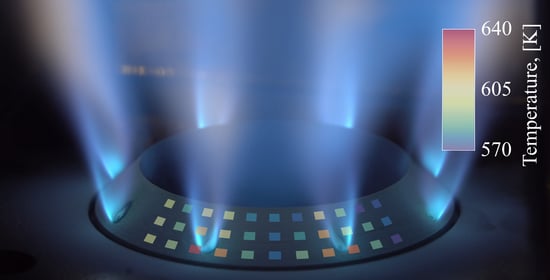Impact of Methane and Hydrogen-Enriched Methane Pilot Injection on the Surface Temperature of a Scaled-Down Burner Nozzle Measured Using Phosphor Thermometry
Abstract
:1. Introduction
2. Materials and Methods
2.1. Burner and Mixture Properties
2.2. OH-PLIF Method
2.3. Phosphor Thermometry Measurement
3. Results
3.1. Overview of the Results
3.2. DP1 Pilot Hardware Configuration
3.3. PP2 and PP3 Pilot Hardware Configurations
4. Conclusions
- The nozzle surface temperatures are governed by the balance between the cooling effect of the pilot air and fuel streams and the heating from the main and the pilot flames. With pure methane fuel, the pilot flames provided quite low local heating to the burner nozzle due to the pilot flames not being closely attached to the surface of the nozzle. With the H2/CH4 fuel, the local heating from the pilot flame was more significant due to the pilot flames being in general more closely attached to the pilot nozzle.
- H2-enrichment of the methane fuel impacts the surface temperatures in two counteracting ways. First, the lower equivalence ratio decreases flame temperature and the heating from the main flame thereby decreasing the surface temperatures. Second, the higher reactivity and diffusivity of H2 help the pilot flames attach to the pilot nozzles, thus promoting an increase in the nozzle surface temperature in the non-premixed pilot injection strategies.
- The mixing of the pilot air and fuel streams has significant impact on the surface temperatures. The non-premixed pilot (DP1) results differ significantly from the partially premixed ones due to the different pilot flame structures. The non-premixed pilot flames with methane as fuel are in general lifted off the nozzle; thus, air flow cooling plays a dominant role. The pilot injection strategy without pilot fuel and air injection (A0F0) has the highest surface temperature due to absence of air flow cooling.
- The surface temperature of the PP3 nozzle is overall 20 K higher than PP2 for both the CH4 and H2/CH4 fuels. This is due to the higher degree of fuel/air mixing of PP3 nozzle than PP2 leading to more closely anchored pilot flames. Both premixed pilot configurations showed, in general, minor surface temperature dependence on the pilot injection strategies with CH4 due to the lifted pilot flame structures. For PP3 with the H2/CH4 fuel, the surface temperature increased significantly for the A1F6 and A2F6 cases due to the increased heat load to the surface, while the temperature for PP2 remained very similar to the other pilot injection strategies.
- The azimuthal variation of the surface temperature indicated that the structure of the inner channels used to transport the pilot fuel and air streams do have a measurable impact on the surface temperatures.
Author Contributions
Funding
Institutional Review Board Statement
Informed Consent Statement
Data Availability Statement
Conflicts of Interest
References
- Schefer, R. Reduced Turbine Emissions Using Hydrogen-Enriched Fuels. In Proceedings of the 2002 US DOE Hydrogen Program Review, Golden, CO, USA, 6–10 May 2002; pp. 1–16. [Google Scholar]
- Schefer, R.W.; Wicksall, D.M.; Agrawal, A.K. Combustion of hydrogen-enriched methane in a lean premixed swirl-stabilized burner. Proc. Combust. Inst. 2002, 29, 843–851. [Google Scholar] [CrossRef]
- Wicksall, D.M.; Agrawal, A.K.; Schefer, R.W.; Keller, J.O. Fuel Composition Effects on the Velocity Field in a Lean Premixed Swirl-Stabilized Combustor. Turbo Expo: Power Land Sea Air 2003, 36851, 539–548. [Google Scholar]
- Candel, S.; Durox, D.; Schuller, T.; Bourgouin, J.F.; Moeck, J.P. Dynamics of swirling flames. Annu. Rev. Fluid Mech. 2014, 46, 147–173. [Google Scholar] [CrossRef]
- Gupta, A.K.; Syred, N.; Lilley, D.G. Swirl Flows; Taylor & Francis: Oxfordshire, UK, 1984. [Google Scholar]
- Syred, N.; Chigier, N.A.; Beér, J.M. Flame stabilization in recirculation zones of jets with swirl. Symp. Combust. 1971, 13, 617–624. [Google Scholar] [CrossRef]
- Syred, N.; Beér, J.M. Combustion in swirling flows: A review. Combust. Flame 1974, 23, 143–201. [Google Scholar]
- Weber, R.; Dugué, J. Combustion accelerated swirling flows in high confinements. Prog. Energy Combust. Sci. 1992, 18, 349–367. [Google Scholar] [CrossRef]
- Weigand, P.; Meier, W.; Duan, X.R.; Stricker, W.; Aigner, M. Investigations of swirl flames in a gas turbine model combustor: I. Flow field, structures, temperature, and species distributions. Combust. Flame 2006, 144, 205–224. [Google Scholar] [CrossRef]
- Formation of Nitric Oxides. In Combustion: Physical and Chemical Fundamentals, Modeling and Simulation, Experiments, Pollutant Formation; Springer: Berlin/Heidelberg, Germany, 2006; pp. 259–276.
- Michaud, M.G.; Westmoreland, P.R.; Feitelberg, A.S. Chemical mechanisms of NOx formation for gas turbine conditions. Symp. Combust. 1992, 24, 879–887. [Google Scholar] [CrossRef]
- Zeldovich, Y.B. The Oxidation of Nitrogen in Combustion and Explosions. In Selected Works of Yakov Borisovich Zeldovich, Volume I: Chemical Physics and Hydrodynanics; Sunyaev, R.A., Ed.; Princeton University Press: Princeton, NJ, USA, 2014; pp. 364–403. [Google Scholar]
- Kim, W.-W.; Lienau, J.J.; van Slooten, P.R.; Colket, M.B., III; Malecki, R.E.; Syed, S. Towards Modeling Lean Blow Out in Gas Turbine Flameholder Applications. In Proceedings of the Turbo Expo: Power for Land, Sea, and Air, Vienna, Austria, 14–17 June 2004; pp. 623–633. [Google Scholar]
- Matalon, M. Intrinsic flame instabilities in premixed and nonpremixed combustion. Annu. Rev. Fluid Mech. 2007, 39, 163–191. [Google Scholar] [CrossRef] [Green Version]
- Sankaran, R.; Im, H.G. Effects of hydrogen addition on the markstein length and flammability limit of stretched methane/air premixed flames. Combust. Sci. Technol. 2006, 178, 1585–1611. [Google Scholar] [CrossRef]
- Mandilas, C.; Ormsby, M.P.; Sheppard, C.G.W.; Woolley, R. Effects of hydrogen addition on laminar and turbulent premixed methane and iso-octane-air flames. Proc. Combust. Inst. 2007, 31, 1443–1450. [Google Scholar] [CrossRef]
- Subash, A.A.; Collin, R.; Aldén, M.; Kundu, A.; Klingmann, J. Experimental Investigation of the Influence of Burner Geometry on Flame Characteristics at a Dry Low Emission Industrial Prototype Burner at Atmospheric Pressure Conditions. In Proceedings of the ASME Turbo Expo 2017: Turbomachinery Technical Conference and Exposition. Volume 4A: Combustion, Fuels and Emissions, Charlotte, NC, USA, 26–30 June 2017. V04AT04A058. ASME. [Google Scholar]
- Albrecht, P.; Speck, S.; Schimek, S.; Bauermeister, F.; Paschereit, C.O.; Gutmark, E. Lean blowout control using an auxiliary premixed flame in a swirl-stabilized combustor. In Proceedings of the Collection of Technical Papers—43rd AIAA/ASME/SAE/ASEE Joint Propulsion Conference, Cincinnati, OH, USA, 8–11 July 2007; Volume 6. [Google Scholar]
- Subash, A.A.; Collin, R.; Aldén, M.; Kundu, A.; Klingmann, J. Investigation of Hydrogen Enriched Methane Flame in a Dry Low Emission Industrial Prototype Burner at Atmospheric Pressure Conditions. In Proceedings of the ASME Turbo Expo 2017: Turbomachinery Technical Conference and Exposition. Volume 4A: Combustion, Fuels and Emissions, Charlotte, NC, USA, 26–30 June 2017. V04AT04A056. ASME. [Google Scholar]
- Brübach, J.; Pflitsch, C.; Dreizler, A.; Atakan, B. On surface temperature measurements with thermographic phosphors: A review. Prog. Energy Combust. Sci. 2013, 39, 37–60. [Google Scholar] [CrossRef]
- Aldén, M.; Omrane, A.; Richter, M.; Särner, G. Thermographic phosphors for thermometry: A survey of combustion applications. Prog. Energy Combust. Sci. 2011, 37, 422–461. [Google Scholar] [CrossRef]
- Heyes, A.L.; Seefeldt, S.; Feist, J.P. Two-colour phosphor thermometry for surface temperature measurement. Opt. Laser Technol. 2006, 38, 257–265. [Google Scholar] [CrossRef]
- Petit, S.; Xavier, P.; Godard, G.; Grisch, F. Improving the temperature uncertainty of Mg4FGeO6:Mn4+ ratio-based phosphor thermometry by using a multi-objective optimization procedure. Appl. Phys. B 2022, 128, 57. [Google Scholar] [CrossRef]
- Jones, E.M.C.; Jones, A.R.; Hoffmeister, K.N.G.; Winters, C. Advances in phosphor two-color ratio method thermography for full-field surface temperature measurements. Meas. Sci. Technol. 2022, 33, 85201. [Google Scholar] [CrossRef]
- Fuhrmann, N.; Brübach, J.; Dreizler, A. Phosphor thermometry: A comparison of the luminescence lifetime and the intensity ratio approach. Proc. Combust. Inst. 2013, 34, 3611–3618. [Google Scholar] [CrossRef]
- Brites, C.D.S.; Balabhadra, S.; Carlos, L.D. Lanthanide-Based Thermometers: At the Cutting-Edge of Luminescence Thermometry. Adv. Opt. Mater. 2019, 7, 1801239. [Google Scholar] [CrossRef] [Green Version]
- Nau, P.; Yin, Z.; Lammel, O.; Meier, W. Wall Temperature Measurements in Gas Turbine Combustors with Thermographic Phosphors. J. Eng. Gas Turbines Power 2019, 141, 041021. [Google Scholar] [CrossRef] [Green Version]
- Nau, P.; Görs, S.; Arndt, C.; Witzel, B.; Endres, T. Wall temperature measurements in a full-scale gas turbine combustor test rig with fiber coupled phosphor thermometry. J. Turbomach. 2021, 143, 011007. [Google Scholar] [CrossRef]
- Eldridge, J.I.; Allison, S.W.; Jenkins, T.P.; Gollub, S.L.; Hall, C.A.; Walker, D.G. Surface temperature measurements from a stator vane doublet in a turbine afterburner flame using a YAG:Tm thermographic phosphor. Meas. Sci. Technol. 2016, 27, 125205. [Google Scholar] [CrossRef]
- Euler, M.; Zhou, R.; Hochgreb, S.; Dreizler, A. Temperature measurements of the bluff body surface of a swirl burner using phosphor thermometry. Combust. Flame 2014, 161, 2842–2848. [Google Scholar] [CrossRef]
- Arndt, C.M.; Nau, P.; Meier, W. Characterization of wall temperature distributions in a gas turbine model combustor measured by 2D phosphor thermometry. Proc. Combust. Inst. 2021, 38, 1867–1875. [Google Scholar] [CrossRef]
- Hodzic, E.; Yu, S.; Subash, A.A.; Liu, X.; Szasz, R.; Li, Z.; Aldén, M. Numerical and Experimental Investigation of the CeCOST Swirl Burner. In Proceedings of the ASME Turbo Expo 2018: Turbomachinery Technical Conference and Exposition. Volume 4A: Combustion, Fuels, and Emissions, Oslo, Norway, 11–15 June 2018. V04AT04A056. ASME. [Google Scholar]
- Subash, A.A.; Yu, S.; Liu, X.; Bertsch, M.; Szasz, R.; Li, Z.; Bai, X.; Aldén, M.; Lörstad, D. Flame investigations of a laboratory-scale CECOST swirl burner at atmospheric pressure conditions. Fuel 2020, 279, 118421. [Google Scholar] [CrossRef]
- Pignatelli, F.; Kim, H.; Subash, A.A.; Liu, X.; Szasz, R.Z.; Bai, X.S.; Brackmann, C.; Aldén, M.; Lörstad, D. Pilot Impact on Turbulent Premixed Methane/Air and Hydrogen-Enriched Methane/Air Flames in a Laboratory-Scale Gas Turbine Model Combustor. Int. J. Hydrog. Energy 2022, 47, 25404–25417. [Google Scholar] [CrossRef]
- Hodzic, E. Analysis of Flow Dynamics and Flame Stabilization in Gas Turbine Related Combustors. Ph.D. Thesis, Lund University, Lund, Sweden, 2016. [Google Scholar]
- Liu, X.; Bertsch, M.; Subash, A.A.; Yu, S.; Szasz, R.-Z.; Li, Z.; Petersson, P.; Bai, X.-S.; Aldén, M.; Lörstad, D. Investigation of turbulent premixed methane/air and hydrogen-enriched methane/air flames in a laboratory-scale gas turbine model combustor. Int. J. Hydrog. Energy 2021, 46, 13377–13388. [Google Scholar] [CrossRef]
- Li, Z.S.; Li, B.; Sun, Z.W.; Bai, X.S.; Aldén, M. Turbulence and combustion interaction: High resolution local flame front structure visualization using simultaneous single-shot PLIF imaging of CH, OH, and CH2O in a piloted premixed jet flame. Combust. Flame 2010, 157, 1087–1096. [Google Scholar] [CrossRef]
- Bechtel, J.H.; Teets, R.E. Hydroxyl and its concentration profile in methane-air flames. Appl. Opt. 1979, 18, 4138. [Google Scholar] [CrossRef]
- Someya, S.; Uchida, M.; Tominaga, K.; Terunuma, H.; Li, Y.; Okamoto, K. Lifetime-based phosphor thermometry of an optical engine using a high-speed CMOS camera. Int. J. Heat Mass Transf. 2011, 54, 3927–3932. [Google Scholar] [CrossRef]
- Kissel, T.; Baum, E.; Dreizler, A.; Brübach, J. Two-dimensional thermographic phosphor thermometry using a CMOS high speed camera system. Appl. Phys. B Lasers Opt. 2009, 96, 731–734. [Google Scholar] [CrossRef]
- Heyes, A.L. On the design of phosphors for high-temperature thermometry. J. Lumin. 2009, 129, 2004–2009. [Google Scholar] [CrossRef]
- Allison, S.W.; Beshears, D.L.; Cates, M.R.; Scudiere, M.B.; Shaw, D.W.; Ellis, A.D. Luminescence of YAG:Dy and YAG:Dy, Er crystals to 1700 °C. Meas. Sci. Technol. 2020, 31, 044001. [Google Scholar] [CrossRef]
- Särner, G.; Richter, M.; Aldén, M. Investigations of blue emitting phosphors for thermometry. Meas. Sci. Technol. 2008, 19, 125304. [Google Scholar] [CrossRef]
- Nada, F.A.; Knappe, C.; Xu, X.; Richter, M.; Aldén, M. Development of an automatic routine for calibration of thermographic phosphors. Meas. Sci. Technol. 2014, 25, 025201. [Google Scholar] [CrossRef]
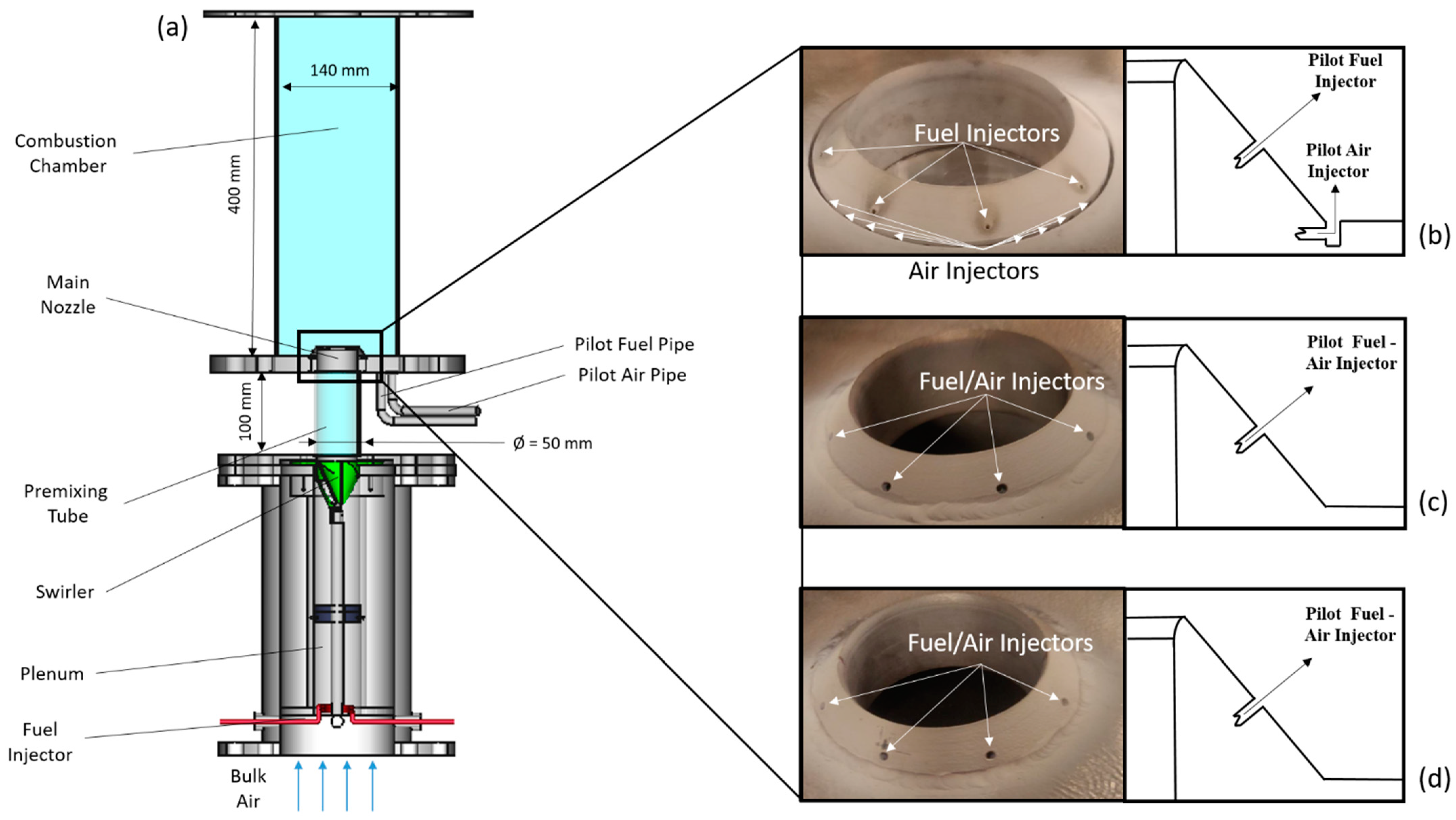


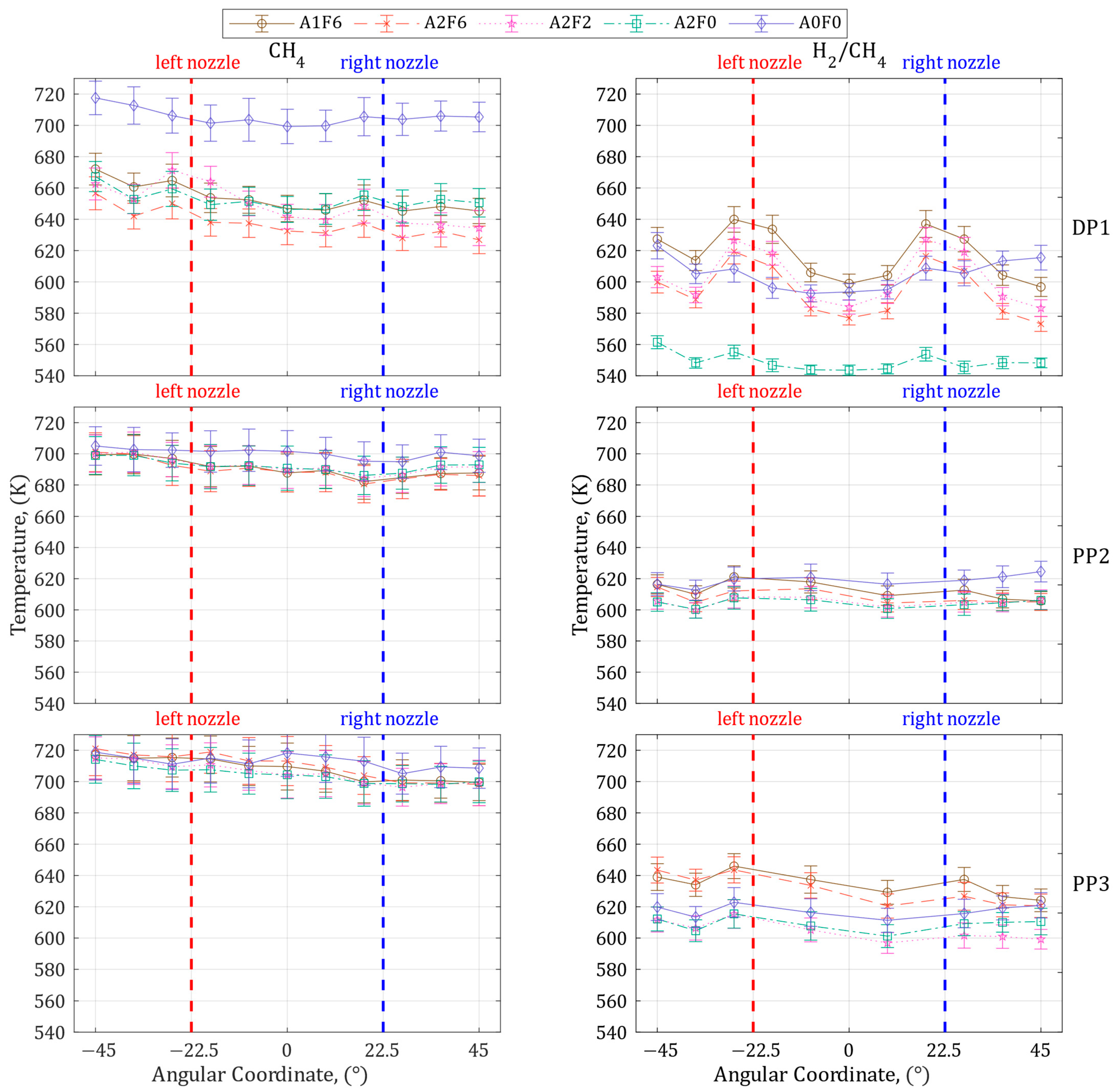


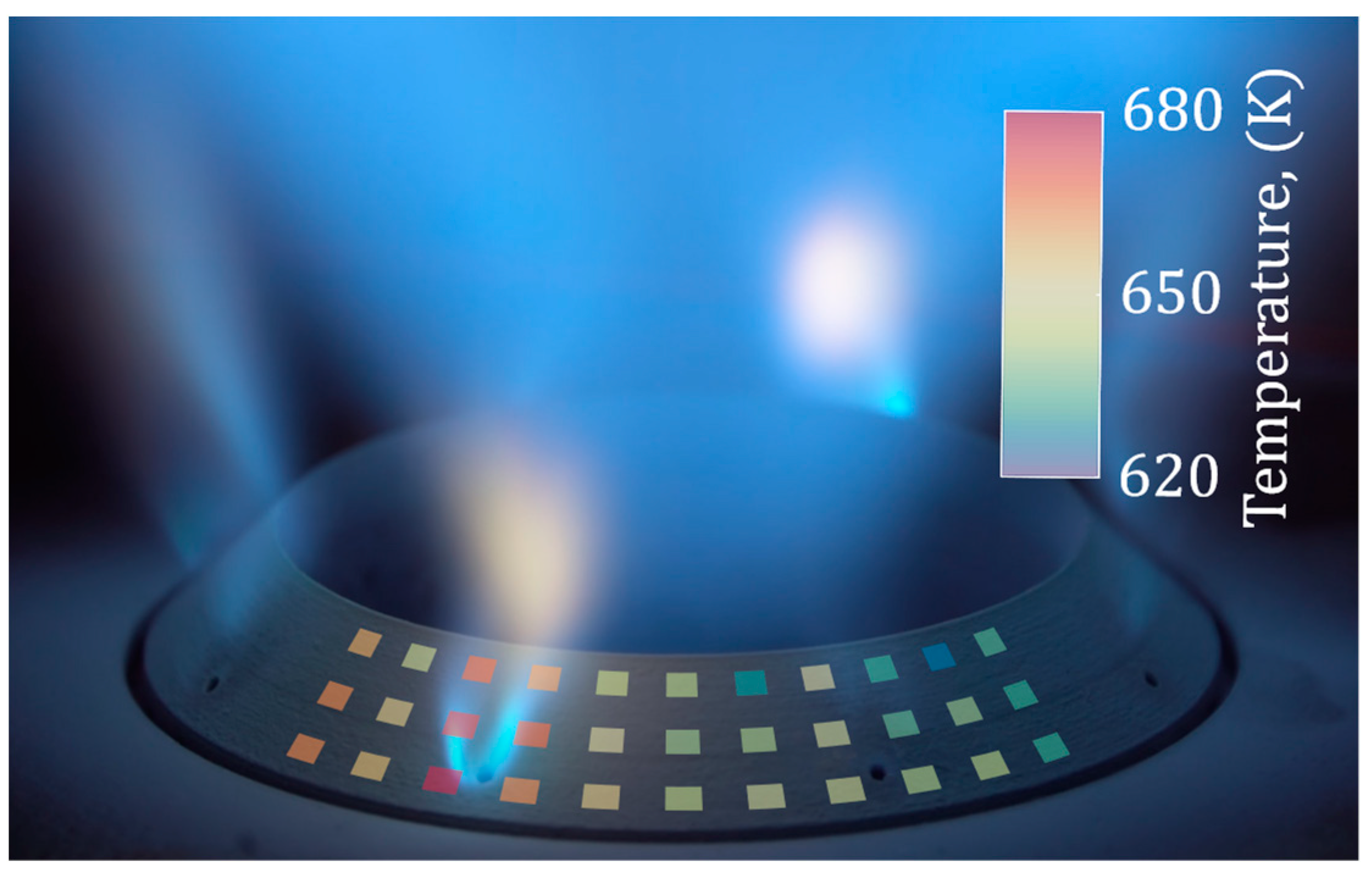


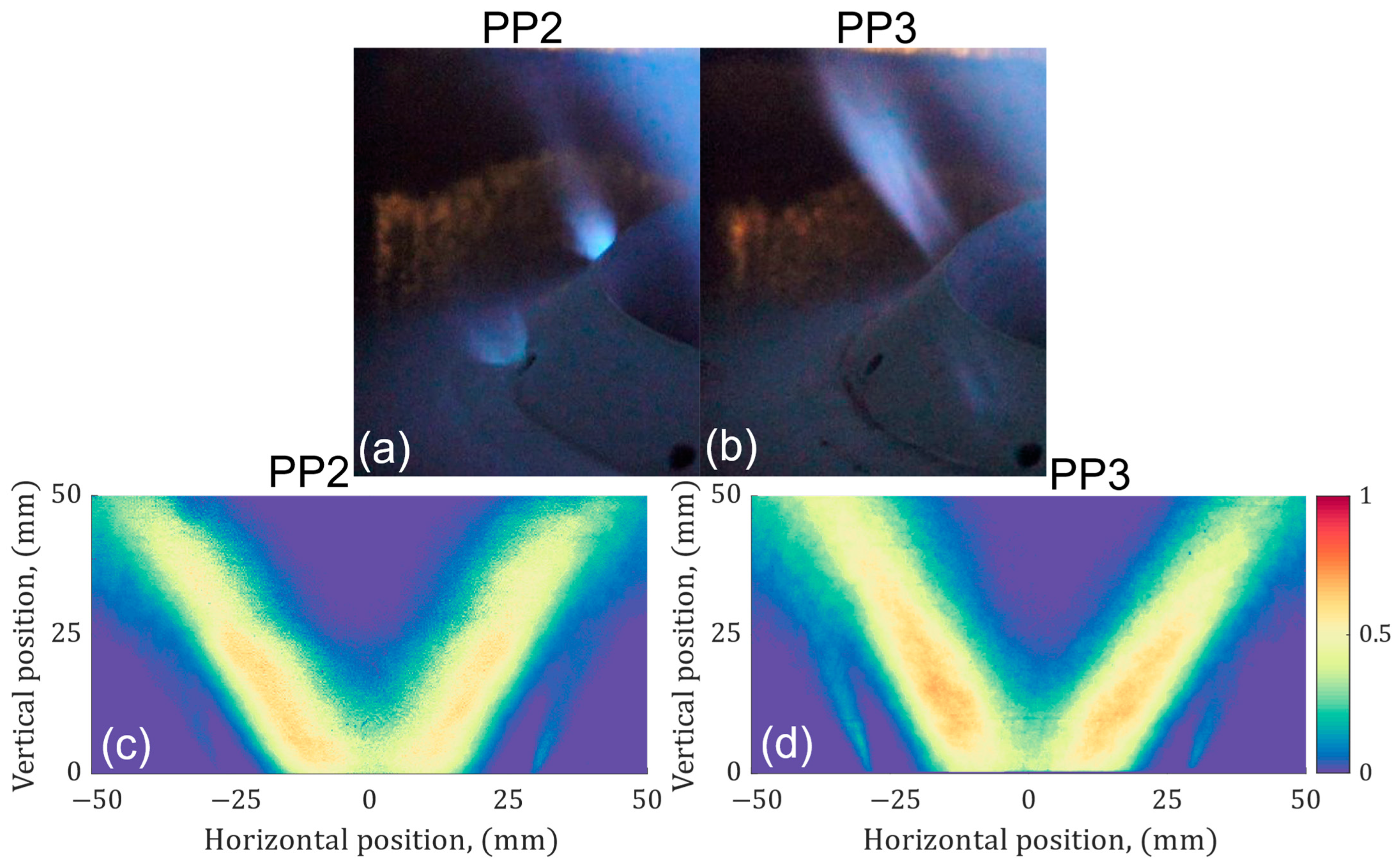
| Injection Strategy | Pilot Air (%) | Pilot Fuel (%) | ||||
|---|---|---|---|---|---|---|
| A1F6 | 1 | 6 | 0.68 | 4.32 | 0.49 | 3.12 |
| A2F6 | 2 | 6 | 0.69 | 2.16 | 0.50 | 1.56 |
| A2F2 | 2 | 2 | 0.72 | 0.72 | 0.52 | 0.52 |
| A2F0 | 2 | 0 | 0.74 | 0 | 0.53 | 0 |
| A0F0 | 0 | 0 | 0.72 | 0 | 0.52 | 0 |
Publisher’s Note: MDPI stays neutral with regard to jurisdictional claims in published maps and institutional affiliations. |
© 2022 by the authors. Licensee MDPI, Basel, Switzerland. This article is an open access article distributed under the terms and conditions of the Creative Commons Attribution (CC BY-NC-ND) license (https://creativecommons.org/licenses/by-nc-nd/4.0/).
Share and Cite
Feuk, H.; Pignatelli, F.; Subash, A.; Bi, R.; Szász, R.-Z.; Bai, X.-S.; Lörstad, D.; Richter, M. Impact of Methane and Hydrogen-Enriched Methane Pilot Injection on the Surface Temperature of a Scaled-Down Burner Nozzle Measured Using Phosphor Thermometry. Int. J. Turbomach. Propuls. Power 2022, 7, 29. https://doi.org/10.3390/ijtpp7040029
Feuk H, Pignatelli F, Subash A, Bi R, Szász R-Z, Bai X-S, Lörstad D, Richter M. Impact of Methane and Hydrogen-Enriched Methane Pilot Injection on the Surface Temperature of a Scaled-Down Burner Nozzle Measured Using Phosphor Thermometry. International Journal of Turbomachinery, Propulsion and Power. 2022; 7(4):29. https://doi.org/10.3390/ijtpp7040029
Chicago/Turabian StyleFeuk, Henrik, Francesco Pignatelli, Arman Subash, Ruike Bi, Robert-Zoltán Szász, Xue-Song Bai, Daniel Lörstad, and Mattias Richter. 2022. "Impact of Methane and Hydrogen-Enriched Methane Pilot Injection on the Surface Temperature of a Scaled-Down Burner Nozzle Measured Using Phosphor Thermometry" International Journal of Turbomachinery, Propulsion and Power 7, no. 4: 29. https://doi.org/10.3390/ijtpp7040029




